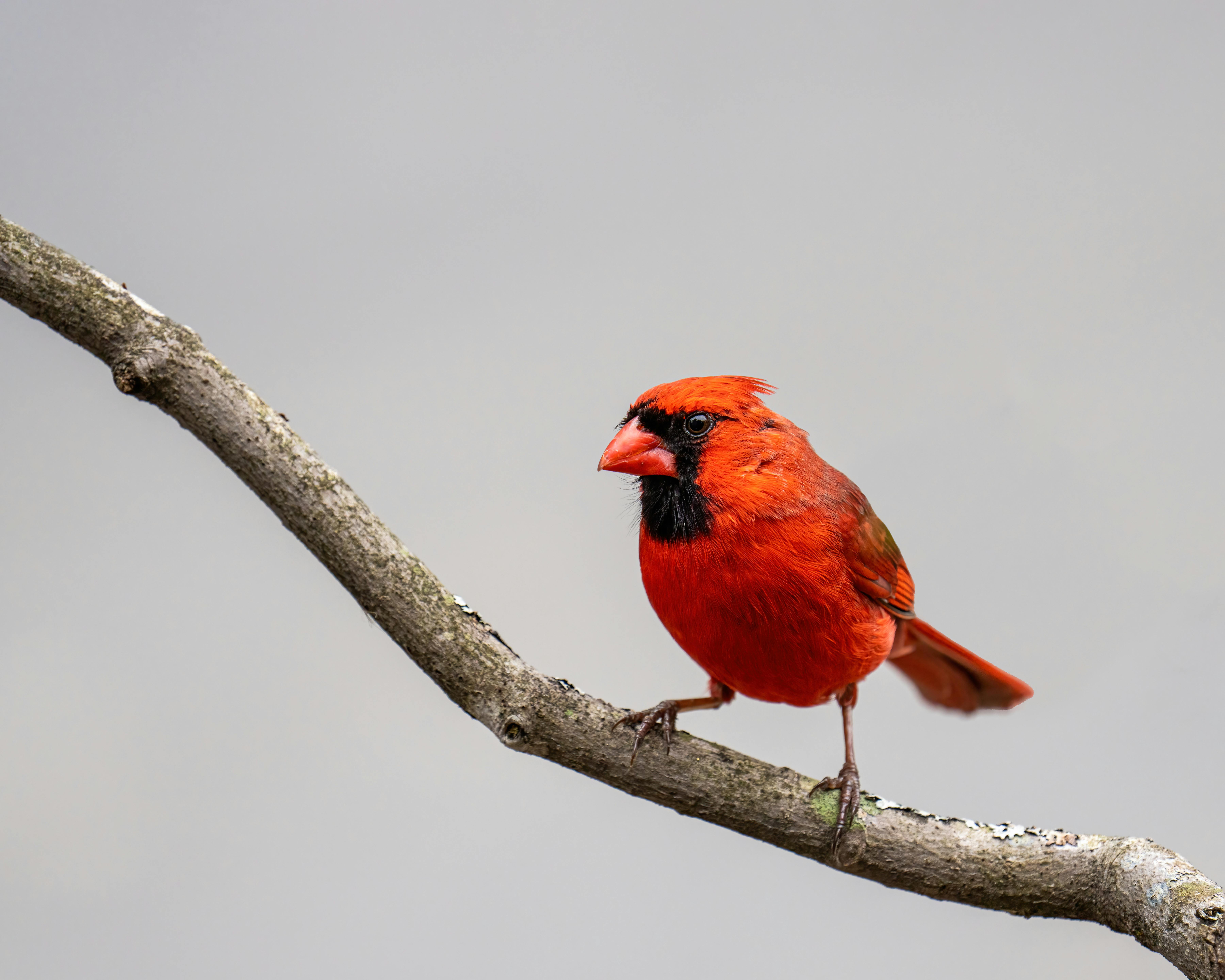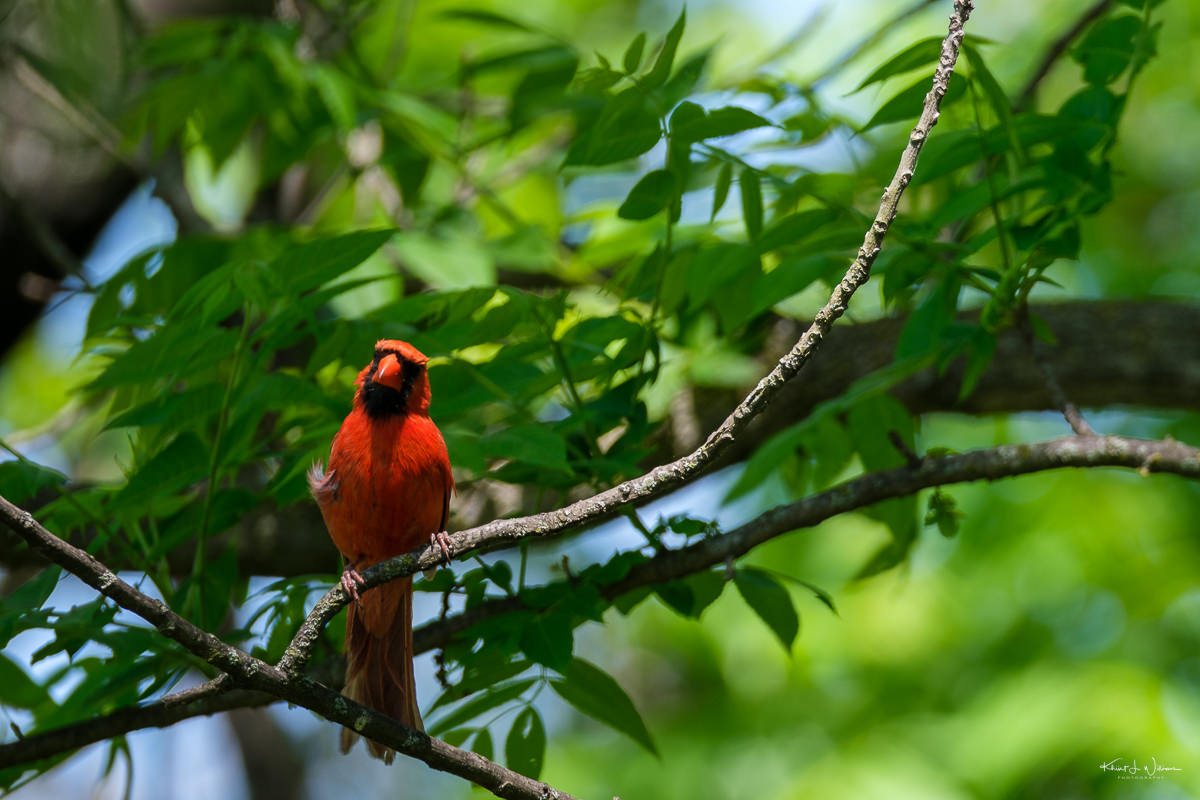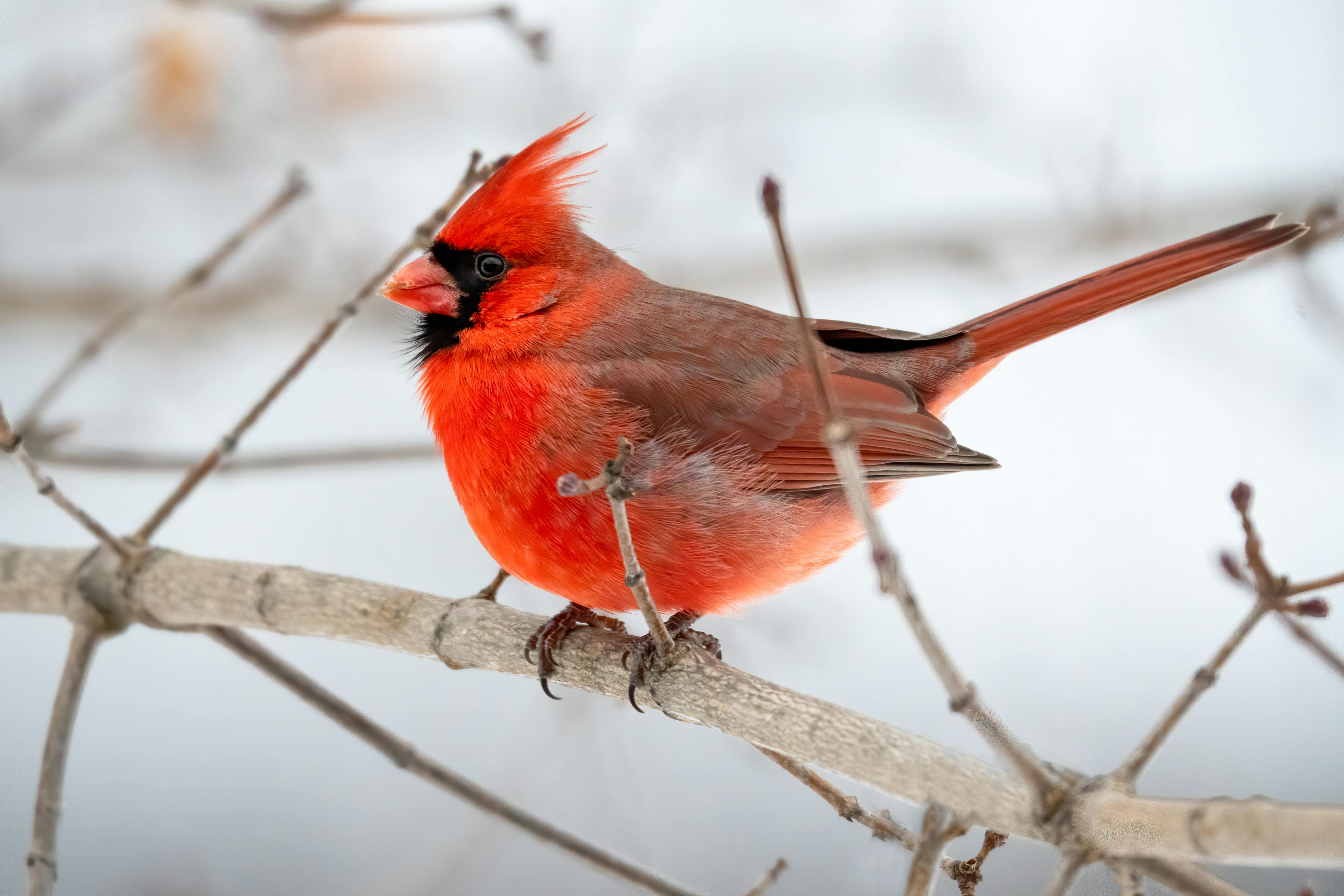Overview of Cardinals’ Distinctive Appearance

Cardinals are captivating songbirds known for their vibrant colors and unique features. The male cardinal boasts a striking coat of bright red feathers that cover its entire body, including the head crest, wings, and tail. In contrast, female cardinals exhibit a more modest appearance with grayish-brown plumage and hints of red on their crest, wings, and tail. Both genders have a short, stout beak colored in a rich orange-red tone and a crest atop their heads that can be raised or lowered to convey different moods. Cardinals have a wingspan of approximately 10-12 inches (25-30 cm) and an average length of 8-9 inches (20-23 cm), with sturdy legs and feet well-suited for perching and climbing.
Intricate Coloration of Cardinals

The male cardinal showcases an arresting red plumage, ranging from deep crimson to vibrant scarlet, while the female cardinal exhibits a more subdued coloration with grayish-brown tones and subtle hints of red. Juvenile cardinals have a combination of gray, brown, and muted red hues, gradually transitioning to the brighter red of adult males as they mature. While the cardinal possesses a distinct appearance, there are a few other bird species that can be mistaken for cardinals due to their similar coloration, such as the Pyrrhuloxia.
Size and Presence of Cardinals
![]()
Cardinals are medium-sized birds, measuring approximately 8 to 9 inches (20 to 23 cm) in length, with a wingspan of about 10 to 12 inches (25 to 30 cm). Their robust and compact build, rounded body, and short tail contribute to their distinctive physique. Male cardinals are slightly larger, weighing approximately 2.1 ounces (60 grams), while females weigh around 1.8 ounces (50 grams). The cardinal’s size sets it apart from smaller songbirds and larger birds, making it easily distinguishable in the avian world.
Notable Features of Cardinals
![]()
Cardinals possess several distinctive features that contribute to their unique appearance and adaptability in their habitat:
- Bright Red Plumage: The cardinal’s vibrant red feathers, particularly among males, aid in easy identification and create a visual spectacle.
- Crested Head: Sporting a prominent tuft of feathers, cardinals have a crest that adds to their charm and allure.
- Black Mask: Both male and female cardinals exhibit a striking black mask encircling their eyes, creating a captivating contrast against their red plumage.
- Short, Stout Beak: Cardinals have a specialized beak for cracking open seeds and nuts, their primary food source.
- Strong Legs and Feet: Equipped with strong limbs, cardinals demonstrate remarkable dexterity in perching and hopping.
- Medium-Sized Body: Cardinals’ stocky build and rounded body shape contribute to their distinct appearance.
- Sexual Dimorphism: Male and female cardinals exhibit pronounced differences in appearance, aiding in various aspects of their reproductive behavior.
With their captivating colors and remarkable features, cardinals showcase their adaptability and resilience in their natural habitats.
Song: The Melodious Symphony of a Cardinal
![]()
The cardinal‘s song is a remarkable and recognizable feature that captivates listeners with its melodious nature. Described as a series of clear, whistling notes, it echoes through the air, filling the environment with vibrant melodies.
Primarily sung by the male cardinal, the song serves multiple purposes. It establishes territory, attracts mates, and communicates with other cardinals. Composed of dynamic and diverse phrases consisting of two to five or more notes, each musical expression varies in length and complexity. Even from a considerable distance, the song’s clarity and strength enchant listeners for several seconds.
While cardinals sing year-round, their songs peak during the spring breeding season. The male cardinal’s exuberant serenades to potential mates assert his presence in the avian community. The cardinal’s song is distinctive and unique, reflecting its cheerful and lively nature that complements its vibrant red appearance. Bird enthusiasts and nature lovers find solace and delight in this melodic touch to the symphony of the natural world.
Habits: Insights into the Behavior and Charms of Cardinals

Cardinals exhibit fascinating behavior and habits that shed light on their daily lives and interactions within their environment.
Territorial Instincts
Renowned for their strong territorial instincts, male cardinals vigorously defend their nesting territories against intruders, including other males. This territoriality safeguards their preferred foraging areas and nesting sites.
Monogamous Bonds

Cardinals form strong pair bonds, remaining together for multiple breeding seasons. The male cardinal actively engages in courtship, using elaborate displays to attract a mate. Once paired, both male and female cardinals collaborate in nest-building, incubation, and feeding their young.
Feeding Habits
As primarily seed-eaters, cardinals have a varied diet comprising different types of seeds found in their habitat. They particularly favor sunflower and safflower seeds. During the breeding season, cardinals incorporate insects and fruits into their diet, providing essential protein for their growing nestlings.
Melodious Songs
![]()
One of the cardinal’s most enchanting habits is its melodious singing. Both male and female cardinals are accomplished singers, using their songs to communicate with their mates and establish territories. The songs consist of a series of clear whistles, warbles, and trills, attracting mates, asserting territory ownership, and warning off rivals.
Diurnal Nature
Cardinals are diurnal birds, active during the day and resting or sleeping at night. They exploit daylight hours for foraging, courtship, and social interactions. Their vibrant plumage and distinctive songs make them a beautiful and prominent presence in the daylight hours.
Cardinals possess a captivating array of behaviors and habits that contribute to their charm and uniqueness. Understanding their territoriality, monogamous bonds, feeding habits, melodious songs, and diurnal nature helps paint a comprehensive picture of these remarkable birds.
Habitat: The Preferred Environment of Cardinals

Cardinals, with their vibrant plumage and melodious songs, primarily inhabit North America, spanning the eastern and southeastern parts of the continent. These adaptable birds thrive in various habitats, showcasing their versatility and resilience.
While cardinals can be found in forests, woodlands, gardens, parks, and residential areas, they favor specific environments that suit their needs. They are commonly associated with edges and open areas within forests, such as clearings, edges, and brushy areas. These locations provide a balance of shelter and access to food sources.
Thickets, shrubs, and dense vegetation serve as vital components of a cardinal’s preferred habitat, offering necessary cover and protection for nesting and foraging. They inhabit both deciduous and coniferous forests but exhibit a preference for areas with a mixture of trees and shrubs, capitalizing on the resources provided by both.
Water sources play a significant role in a cardinal’s habitat selection. Cardinals congregate near streams, rivers, wetlands, and marshes, relying on reliable water supplies for drinking and bathing to maintain their health and vitality.
Cardinals typically remain in their habitat year-round, adjusting their feeding and nesting patterns based on seasonal changes and food availability. They have also demonstrated adaptability to urban environments, thriving in suburban areas with adequate vegetation and food sources like bird feeders and fruit-bearing trees.
Creating an ideal habitat for cardinals involves cultivating dense shrubs, bushes, and a variety of trees, providing nesting sites and an abundant supply of insects, seeds, fruits, and berries. By understanding and respecting their habitat preferences, we can appreciate and support the thriving populations of these magnificent birds.
Diet: What Cardinals Typically Eat
![]()
Cardinals, with their vibrant red plumage and distinctive crests, have captivating dietary preferences. These primarily seed-eating birds rely on seeds for their nutritional needs. Their diet consists of various types of seeds, including sunflower, safflower, and wild grass seeds. During winter, when seeds are scarce, cardinals turn to fruits such as berries as an alternative food source. In fact, they particularly favor the bright red berries of holly, dogwood, and sumac.
While seeds and fruits dominate their diet, cardinals occasionally incorporate insects and small invertebrates, especially during the breeding season. Beetles, grasshoppers, and spiders provide valuable protein for the growing chicks. Among the seed options, cardinals strongly prefer black oil sunflower seeds, which are rich in fat and provide the necessary energy to endure cold winters. To attract cardinals to your backyard, providing a consistent supply of black oil sunflower seeds can be highly effective.
Cardinals are primarily ground feeders, foraging for food on the ground or in low vegetation. However, they also visit bird feeders that offer their preferred seeds. By offering a variety of food sources, including seeds, fruits, and insects, you can attract these delightful birds to your yard and provide them with the necessary sustenance. The specific dietary preferences of cardinals may vary slightly depending on their geographical location and food availability in their habitat. However, their reliance on seeds, supplemented by fruits and insects, remains consistent across their range.
Mating: How Cardinals Mate and Reproduce

Cardinals are renowned for their monogamous nature, forming long-term pair bonds with a single mate. Mating season typically occurs in early spring, with male cardinals engaging in courtship behavior to attract a female mate. They showcase their vibrant red plumage, sing complex and melodious songs, and engage in courtship rituals such as puffing up their feathers and offering food to the female.
Once a pair bond is established, the male and female cardinals engage in mutual preening to strengthen their bond and maintain their plumage. The female takes the responsibility of building the nest, usually located in dense shrubs or trees, using twigs, grass, and leaves. She lays a clutch of 2-5 eggs, which are white or pale green with brown speckles for effective camouflage.
The female incubates the eggs for approximately 11-13 days, while the male provides food for her. After hatching, both parents actively participate in feeding and caring for the altricial chicks. The parents tirelessly gather food and deliver it to the hatchlings, ensuring their healthy growth and development. The period of parental care continues until the chicks fledge and become independent, with young cardinals gradually acquiring their adult plumage.
The mating and reproductive behaviors of cardinals exemplify their commitment to monogamy and cooperative parenting, making them remarkable and endearing birds to observe.
Migration: Cardinals’ Seasonal Movements
![]()
Cardinals are generally considered non-migratory birds, but they engage in limited migration in response to seasonal changes in food availability and harsh weather conditions. During winter, they exhibit short-distance movements known as “irruptive migration.” This behavior involves individuals or small groups moving southward from breeding territories to regions with milder climates and abundant food sources.
While the majority of cardinals remain in their breeding territories year-round, the extent and distance of these irruptive migrations can vary. Factors such as food availability, temperature fluctuations, and habitat conditions influence their movements. Cardinals are primarily found in the eastern and central parts of North America, ranging from southern Canada to the Gulf Coast and extending west to Texas and Oklahoma. In the northern parts of their range, they may experience more significant migratory movements to escape harsh winter conditions.
Cardinal migration is driven by the search for food and suitable habitat, as well as the avoidance of extreme weather conditions. Understanding the factors that influence their movements provides valuable insights into their ecology and survival strategies.
Conclusion: The Captivating Cardinal

The cardinal is a captivating bird native to North and South America. With its distinct features and behaviors, it is easily recognizable and beloved by many.
The male cardinal stands out with its vibrant red plumage. Its body is predominantly red, accompanied by a black face mask extending from its eyes to its throat. It also boasts a black crest atop its head. In contrast, the female cardinal has a more subdued appearance, featuring a light brown or gray coloration with reddish highlights on its wings, tail, and crest.
Both male and female cardinals possess short, stout beaks that are cone-shaped and reddish in color. They also share a distinctive crest on the top of their heads, which can be raised or lowered depending on their mood or alertness. Cardinals have robust legs and sharp claws that facilitate secure perching on branches.
A notable characteristic of the cardinal is its melodious and rich song. Their vocalizations consist of various whistles, trills, and phrases, often described as clear and musical. Cardinals primarily feed on seeds but also consume insects, berries, and fruits.
Known for their monogamous nature, cardinals form long-lasting pair bonds. They are frequently observed in pairs or small family groups. These adaptable birds prefer habitats with dense vegetation, such as woodlands, gardens, and shrubby areas, but can also thrive in urban and suburban environments.
Overall, the cardinal’s vibrant colors, distinctive features, enchanting song, and adaptable nature make it an iconic bird in the Americas. Whether perched on a tree branch or flitting through the foliage, the cardinal adds beauty and charm to our natural surroundings.
Frequently Asked Questions
Can you name birds that resemble cardinals?
The Pyrrhuloxia is a bird species that closely resembles cardinals due to its similar coloration. Native to the southwestern United States and Mexico, the Pyrrhuloxia shares the cardinal’s distinctive crest and has a grayish-brown body with hints of red. However, unlike the cardinal, the Pyrrhuloxia has a gray face and lacks the vibrant red plumage of the male cardinal.
Are there any other birds with red plumage?
Yes, there are several bird species with red plumage. Some examples include the Scarlet Tanager, Summer Tanager, Vermilion Flycatcher, and Northern Flicker (red-shafted subspecies). These birds display various shades of red in their plumage, but they may have different body shapes, beak sizes, and other distinguishing features compared to cardinals.
Do female cardinals have red feathers?

Female cardinals do not have the same vibrant red plumage as their male counterparts. Instead, they exhibit a more subdued appearance with grayish-brown feathers and hints of red on their crest, wings, and tail. The male cardinal’s bright red feathers serve as a visual spectacle, while the female’s coloration provides camouflage for nesting and protecting her young.
Are there any birds similar to cardinals in other parts of the world?
While cardinals are primarily found in North and South America, there are bird species in other parts of the world that share similar traits with cardinals. For example, the Red-crested Cardinal from South America possesses a crest and vibrant red plumage. However, it has a black mask that extends further down its throat compared to the cardinal.
Can cardinals be found outside of North and South America?
Cardinals are primarily native to North and South America and are not typically found in other regions. They are most abundant in eastern and central North America, ranging from southern Canada to the

Leave a Reply